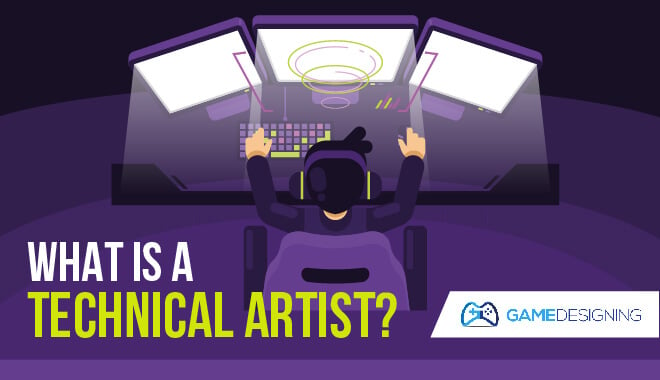
Making a video game requires a number of different skill sets. Developing the systems that allow the game to function is very different from designing a landscape or character model; it’s the difference between game development and game design.
Game development heavily relies on the coding aspect of making a game, while game design works on the world that the players will see. But how can you bridge the gap between them? Well, that is the job of a technical artist.
What is a Technical Artist?
A technical artist is someone who can work with both skill sets. They have an understanding of a game engine and its limitations, as well as how to develop tools to get around them. They also understand the artist’s vision and help supply them with the tools they need to do their work–as well as to avoid incoming roadblocks.
If the art team is having technical trouble, the technical artist is the first person they call. Art assets have to be converted into usable code to be put into the game. But they are neither developers nor are they designers. Instead, they act as a combination of the two.
Can Technical Artists Work on Video Games?

A technical artist has to be comfortable with coding languages such as Python and C++, and have some great communication and organizational skills. Generally, the main goal of a technical artist can be summed up as “Make the process of bringing art into the game faster”. However, doing this could mean many things:
Creating Tools For the Art Team
The main responsibility of a technical artist is to build the tools that the art team will need. While artists may be using programs such as Maya or Photoshop, game design often requires more tools than these systems offer.
A technical artist, for example, may need to build a tool that populates a village with randomized villagers using a number of presets, so the artist doesn’t have to do each villager individually. Or they might develop a tool to count the number of birds appearing in the sky at any given time. Whatever the artist needs, it’s the job of the technical artist to understand it and see if the request is reasonable or not.
Artists might not have the greatest understanding of the programming side of things, so blindly following their requests could lead to problems. Instead, technical artists try to understand their objective and create the tools that get them there without interfering with the programming department.
Troubleshooting
A large part of a technical artist’s job is to troubleshoot problems as they come up. If an artist’s tool isn’t working right, the team is hitting a wall of memory limitations, or an asset isn’t looking like it should, they are the first ones to call.
Often this means finding the problems that might come up, and fixing them before they can even happen. So a technical artist has to be able to pay attention to the work of the entire team and see how things are progressing.
Manage the Game Development Pipeline
The game development pipeline is the chain of events of game development, and how fast the team can get from point A to B with the fewest “clogs”. During development, countless files are being made, shared, updated, saved, or deleted. This can very quickly add up to an overwhelming tidal wave of information that’s impossible to keep track of.
To make sure that doesn’t happen, the technical artist is responsible for organizing this pipeline. This could mean creating programs that help to sort it. A pretty common program they would make is called Version Control.
A version control system saves a file and records any changes each time someone edits or changes a file. That way, if you need to see what a file looked like three weeks ago to correct a mistake, the old version of the file will still exist. Organizing the pipeline could also mean making folders, and renaming files as needed. It’s a lot of work, but absolutely essential to keeping progress on the game moving.
Working With And Creating Shaders
Shaders are programs that run in a render of a scene. In practice, they often become presets of a material, such as a cobblestone road or a grassy field, that can easily be added to tweak and improve the visuals of your game.
It’s not uncommon at all for technical artists to specialize in creating and using shaders. This can quickly improve the look of an environment, saving the art department a lot of time so they can work on the important set pieces.
Rigging and Animation
Rigging is the process of making 3D Models move. Rigging is essentially putting a moveable “bone” into a model so that each limb and part of a model is capable of movement. They are the points that tell your software which parts of a character should move and which shouldn’t.
For example, if you want to have a game character wave naturally, bones will have to be placed in each joint of the arm, as well as the fingers of the hand. A big part of rigging is also making sure that only the parts you wish to move do so. Waving an arm should not move the character’s head.
This can be a time-consuming process, and technical artists will often build tools to make the process of rigging faster.
A technical artist is responsible for all of that and even more. Their job may also involve creating game exporters, making backgrounds, creating textures, and even developing lighting systems. In other words, Technical artists have to have the know-how to do a bit of everything. But it’s all with the central goal of making the process of bringing art into the game faster.
How and Why to Become a Technical Artist

So now that you know what a technical artist does, how do you actually become one? The good news is that they are among the most sought-after people in the game industry. Being a jack-of-all-trades means you can contribute a lot of work to the development team after all. There is always work out there for a technical artist.
Technical Artist Salary
For that reason, the average salary of a technical artist is $71,000 a year, and the more specializations you can do, the better the salary becomes. It’s not uncommon for a technical artist to make over $100,000 yearly if they work for a large enough company.
Education and Skills Needed
But the bad news is that becoming one isn’t easy. They need to have skills in both art and programming. They also need to have more education, experience, and a richer portfolio than most other positions.
Often, this experience is gained through working as either a programmer or an artist first, before developing an interest in the other side of things. But there are still those who attend post-secondary school exclusively to become technical artists.
Generally speaking, to become a technical artist, you should have a degree or diploma in a relevant art study, such as fine arts or graphic design. You should also achieve a degree or diploma in computer science or game development. That comes to a lot of schooling.
However, experience, and building a portfolio of your work are the most important aspects here. If you can work in the gaming industry for a number of years, you can gain the skills a technical artist might need along the way.
To start work in the game industry, practice! Take part in special events where you can network with others in the industry. Try your hand at the 24-hour game dev challenges, or the modding scene. Do everything in your power to get your name out there, and soon you’ll have an idea of the companies you should apply to. You may even make some developer friends along the way.
Building a Technical Art Portfolio
You’ll need to have a passion for game creation, a creative mind, and some projects under your belt before you begin to apply for this job. Taking part in modding, and making small games of your own, is a great way to improve your skills and give you something to show off to employers.
Artstation.com has a great catalog of technical art to browse, that can give you a better idea of the sort of work those technical artists are expected to do. You’ll need to build a portfolio (a collection of your finest technical art) to sell your talents to employers. Make sure that your portfolio focuses on technical art such as shaders and rigging, etc.
When making a portfolio, it’s always best to display your best work that’s the most relevant to the job that you want. Here are a few other quick tips. Also, be clear about which part of the work is yours on projects in which multiple people contributed. You do not want your portfolio to mislead its viewers.
Would You Excel as a Technical Artist?
Even in a field with as many different positions as game development, a technical artist stands out in terms of skill and adaptability. The needs of the developers cannot always be understood by the art department, and vice versa. But a technical artist can cater to the needs of both, keeping the flow of productivity moving.
It may not be the job that gets the most attention from the players themselves, but for the dev team, they are essential to getting the game completed on time and in a good state. It’s no wonder they are so highly sought after by big game companies. In a way, the entire video game itself is one big piece of technical art.




Leave a Reply